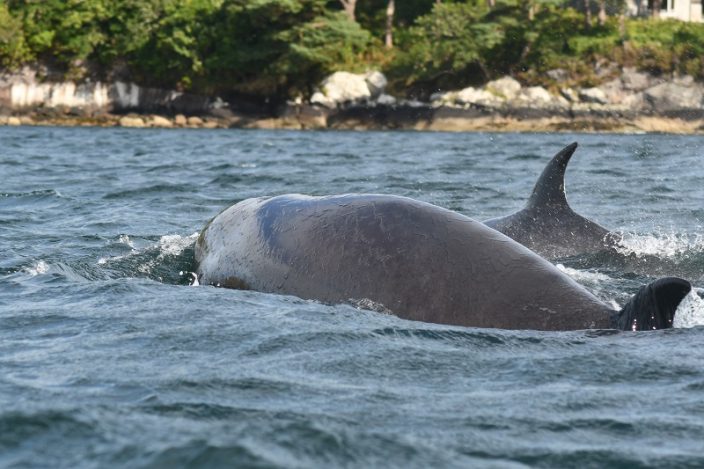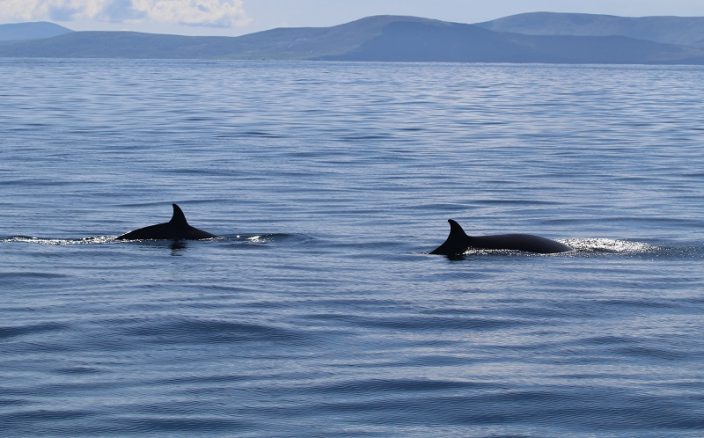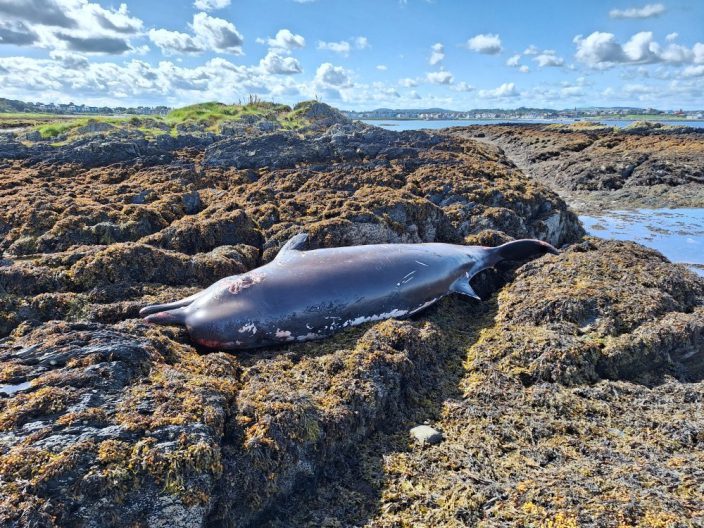Many of our readers recently were following with interest the story of the trio of Northern bottlenose whales Hyperoodon ampullatus that were recorded in inner Bantry Bay, Co. Cork between August 19th to September 3rd 2023. This contribution is by way of bookending the story, while acknowledging there may still be a degree of uncertainty surrounding how exactly it will end.

Pair of Northern Bottlenose Whales Nr. Garnish Island, Bantry bay 29th Aug 2023 © Brendan Quinn
It seems for the first week the best vantage point to observe them from was the Eagle Point Campsite at the tip of the Ballylickey inlet. By the second week there was more movement although it was very limited in range, but sighting reports started placing them off the back of Garnish Island and over towards Whiddy Island. There were two days when there were no sighting reports at all, which was interesting given the high level of interest in them and the still busy time of year. But by Sept. 1st they were back and were seen each day up to and including Sept. 3rd.
Monitoring them remotely then seems to have become a little less straight forward. The schools were all back, the holiday makers had left, which meant fewer eyes on the water and less watch effort; but there a bigger problem, which was the arrival into the area of minke whales, which can lead to confusion between species. Despite their very different ecological niches these two species can be quite difficult to tell apart in certain light conditions, and in profile their body length and dorsal fins are rather similar.
So after Sept. 3rd the few reports that came in curiously came without photos or video, which suggested something had changed, as in the previous weeks the same bottlenose whales had been very easy to capture on film as a result of their regular and prolonged bouts of breaching, often initiated by tail slapping, as well as their short but very reliable “blows” on surfacing. The addition of minke whales and on occasion bottlenose dolphins, to the mix left observers just that little bit less confident when reporting to IWDG. And so for very good reason in the absence of photo evidence or a sound description, we started downgrading sightings to a “minke/Northern bottlenose whale” category, which is code for……they could have been either species. And while this cautious approach may have deprived us of a few days of valuable data on a rarely seen deep- diving beaked whale species, the flip side is that it enables us stand over those sightings in which we had a high degree of confidence. This trade-off is at the heart of validation.

Pair of Northern Bottlenose Whales Blasket Islands, Co. Kerry 16th Aug 2023 © Joanne O’ Brien
But validation is a two way process, so it’s not just about downgrading sightings reports, it’s equally about upgrading and this was very evident in the early days of this story, when many reported these whales to IWDG as, you guessed it…..”pilot whales”. A species which over the past few decades have become a convenient “catch all” when people are confronted with tricky species identification dilemmas.
At time of writing (Sept. 15th) It’s now five days since IWDG has confirmed a sighting of a Northern bottlenose whale in the Bantry Bay area, when a single animal was filmed east of Garnish Island on Sept 10th (courtesy of Noel & Niall Brett). More importantly, there have been no reports received by the IWDG of any stranding (dead or alive) in the area or adjacent waters, which is great news. So this is probably as good a time as any to reflect on this interesting episode.
The sightings history of this species suggest that Northern bottlenose whales just don’t turn up completely unannounced, as their occurrence often seems to have associated satellite events. So in much the same way as these inner Bantry Bay animals showed up within three days of a sighting of two Northern bottlenose whales off the Blaskets in Kerry on August 16th (image courtesy Joanne O’ Brien), something similar occurred back in 2005 when the Puleen Harbour whale in the outer Bay was preceeded by an initial live stranding and subsequent death several days earlier in Haulbowline, Cork harbour of another. And while we can confirm no associated stranding in the southwest during this current event, low and behold we had one in the northeast on August 24th at Ballymacormick Point, Co. Down (image below courtesy Terry McQueen).
That’s three events relating to a species rarely recorded in Irish coastal waters within a nine-day period in Counties Kerry, Cork and Down. The data within the country suggests these are unlikely to be isolated incidents, but when you zoom out to look at what’s happening in neighbouring countries, with strandings or sightings in West Sussex- England, Glengorm in the Hebrides and Skye, Scotland as well as the Faroes and northern France, these events are very difficult to pass off as mere random chance.

Dead Northern Bottlenose Whale, Ballymacormick Pt., Co. Down 24th Aug 2023 © Terry McQueen
Your observations and sighting reports are important and help us build that bigger picture, which in this case lead us to one unavoidable question…….what happened in offshore waters in the days and weeks leading up to these events? It’s difficult to answer this question without speculating, but it’s hard to imagine that the root cause wasn’t at least anthopogenic.
IWDG extend a huge thank you to both staff and guests at Eagle Point Campsite, local members of the Bantry Bay Boats What’s App group and local IWDG members as well as NPWS Conservation rangers for keeping us informed on a daily basis…you know who you are.
Pádraig Whooley, IWDG Sightings Officer

